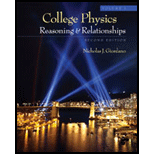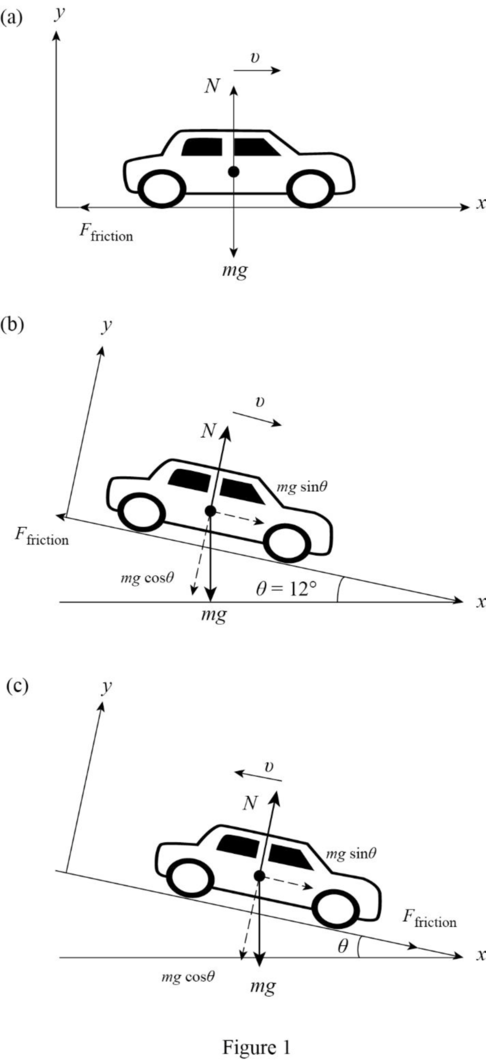
(a)
The distance travelled by the car before it comes to a stop.
(a)
Answer to Problem 85P
The distance travelled by the car before it comes to a stop is
Explanation of Solution

Write the expression for the Newton’s second law along horizontal axis.
Here,
Write the expression for the Newton’s second law along vertical direction.
Here,
Use equation (II) to write the expression for
Use equation (III) in (I) to solve for
Write the expression for the kinematics equation to solve for the distance travelled by the car before it comes to a stop.
Here,
As the care comes to a stop, the final velocity
Use equation (IV) in (V) to solve for
Conclusion:
Substitute
Therefore, the distance travelled by the car before it comes to a stop is
(b)
As the same car is moving downhill along the road makes an angle, the distance travelled by the car before comes to a stop.
(b)
Answer to Problem 85P
As the same car is moving downhill along the road makes an angle, the distance travelled by the car before comes to a stop is
Explanation of Solution
Write the expression for the Newton’s second law along horizontal axis.
Here,
Write the expression for the Newton’s second law along vertical direction.
Here,
Use equation (VIII) to write the expression for
Use equation (IX) in (VII) to solve for
As the care comes to a stop, the final velocity
Write the expression for the kinematics equation to solve for the distance travelled by the car before it comes to a stop.
Here,
Conclusion:
Substitute
Almost double the stopping distance.
Therefore, the same car is moving downhill along the road makes an angle, the distance travelled by the car before comes to a stop is
(c)
As the same car is moving uphill along the road makes an angle, the distance travelled by the car before comes to a stop.
(c)
Answer to Problem 85P
As the same car is moving uphill along the road makes an angle, the distance travelled by the car before comes to a stop is
Explanation of Solution
Write the expression for the Newton’s second law along horizontal axis.
Write the expression for the Newton’s second law along vertical direction.
Use equation (VIII) to write the expression for
Use equation (IX) in (VII) to solve for
As the care comes to a stop, the final velocity
Write the expression for the kinematics equation to solve for the distance travelled by the car before it comes to a stop.
Conclusion:
Substitute
Therefore, the same car is moving uphill along the road makes an angle, the distance travelled by the car before comes to a stop is
Want to see more full solutions like this?
Chapter 4 Solutions
College Physics, Volume 1
- A box of mass 15.7 kg slides down an inclined plane without friction. If the acceleration, a, of the box along the direction of the plane is 4.1 m/s2, what is the angle θ (in degrees) of the plane with respect to the horizontal?arrow_forwardA car with a mass of 1.3x10° kg is skidding to a stop along a horizontal surface. The car decelerates from 33 m/s to rest in 3.9 seconds. Assuming negligible air resistance, determine the coefficient of friction between the car tires and the road surface.arrow_forwardA 129 kg crate is sitting at the top of a ramp, which is inclined at an angle of 20 degrees with respect to the horizontal. Someone gives the crate a quick shove to get it moving, after which it slides down the ramp without any further assistance. The coefficient of kinetic friction between the crate and the ramp is ls = 0.23. What is the magnitude of the acceleration (in m/s?) of the crate?arrow_forward
- consider an object of mass m = 3kg starting at rest sliding down a ramp. Suppose that the ramp make an angle θ = 30◦ relative to the ground. Further, the coefficient of static friction and the coefficient of kinetic friction of the ground and the object surface is μ = 0.4. The edge of the object is distance S = 1 m from the apex.(a) Find the acceleration of the object as it slides down.(b) How long does it take for the object to get to the apex?(c) What is the speed of the object when it reaches the apex?arrow_forwardA mover has to move a heavy sofa of mass 100 kg to the second floor of the house. He uses a rope to pull the sofa up a ramp from the first to the second floor. As he pulls the sofa he makes sure that the rope is parallel to the surface of the ramp which is at 30.0° to the horizontal. If friction between the sofa and the ramp is negligible, and the sofa has an acceleration of 0.800 m/s2, find the tension in the rope (in N). Narrow_forwardA city is trying to determine the speed limit for a given stretch of road. If a stop sign is visible from 62.0m on a straight, horizontal stretch of road and the coefficient of static friction between the road and the tires of a car is 0.525 then what is the maximum speed for a car in meters per second so that it can come to a complete stop at the stop sign?arrow_forward
- A block is sliding down a ramp at an angle of 0 = 16° to the horizontal. Its initial speed is 2.8 m/s. After sliding 13.6 m along the ramp, it comes to a rest. What is the coefficient of kinetic friction, µ., between the block and the ramp? Өarrow_forwardA car is driving along a level and unbanked circular track of diameter d=0.54km at a constant speed of v=21.2m/s. Write an expression for the magnitude of the acceleration of the car in terms of the given parameters.What is the magnitude, in meters per squared second, of the acceleration of the car?Write an expression for the minimum coefficient of friction between the car's tires and the road that is required in order to keep the car going in a circle in terms of the given parameters.What is the value of the minimum coefficient of friction between the car's tires and the road that is required in order to keep the car going in a circle?arrow_forwardExpress answers in significant figures and scientific notation only. An athlete slides down from rest 40.0 meter along an icy hill which is 35 degrees from the horizontal. He then continues sliding on the level ice. a) If the coefficient of kinetic friction between the athlete and ice is 0.20 (neglect air resistance) find speed (m/s) of the athlete at the foot of the plane. b) find the distance (m) from the foot of the plane to the point where he has landed to the level icearrow_forward
- A 40 kg wooden crate is being pulled across a wooden surface by a force (of magnitude F) that is angled 20° above the horizontal. The coefficient of static friction is 0.5 and the coefficient of kinetic friction is 0.3. (a)Calculāte the minimum force F (in N) that must be exerted to get the crate moving. (b)What is the acceleration (in m/s?) of the crate once it starts to move, if that force (F) is maintained?arrow_forwardA trained sea lion slides from rest with constant acceleration down a 3.0-m-long ramp into a pool of water. If the ramp isinclined at an angle of u = 23° above the horizontal and the coefficient of kinetic friction between the sea lion and theramp is 0.26, how much time does it take for the sea lion to make a splash in the pool?arrow_forwardA box is initially sliding up a 32.5° incline at a speed of 13.0 m/s. The coefficients of friction between the incline and the box are uk= 0.680 and us= 0.740. (a) What is the acceleration of the box while it is sliding up the incline? (b) How far will the box travel up the inline before coming to a stop? (c) What would the coefficient of kinetic friction have to be for the box to be able to slide down the ramp at a constant speed?arrow_forward
 College PhysicsPhysicsISBN:9781305952300Author:Raymond A. Serway, Chris VuillePublisher:Cengage Learning
College PhysicsPhysicsISBN:9781305952300Author:Raymond A. Serway, Chris VuillePublisher:Cengage Learning University Physics (14th Edition)PhysicsISBN:9780133969290Author:Hugh D. Young, Roger A. FreedmanPublisher:PEARSON
University Physics (14th Edition)PhysicsISBN:9780133969290Author:Hugh D. Young, Roger A. FreedmanPublisher:PEARSON Introduction To Quantum MechanicsPhysicsISBN:9781107189638Author:Griffiths, David J., Schroeter, Darrell F.Publisher:Cambridge University Press
Introduction To Quantum MechanicsPhysicsISBN:9781107189638Author:Griffiths, David J., Schroeter, Darrell F.Publisher:Cambridge University Press Physics for Scientists and EngineersPhysicsISBN:9781337553278Author:Raymond A. Serway, John W. JewettPublisher:Cengage Learning
Physics for Scientists and EngineersPhysicsISBN:9781337553278Author:Raymond A. Serway, John W. JewettPublisher:Cengage Learning Lecture- Tutorials for Introductory AstronomyPhysicsISBN:9780321820464Author:Edward E. Prather, Tim P. Slater, Jeff P. Adams, Gina BrissendenPublisher:Addison-Wesley
Lecture- Tutorials for Introductory AstronomyPhysicsISBN:9780321820464Author:Edward E. Prather, Tim P. Slater, Jeff P. Adams, Gina BrissendenPublisher:Addison-Wesley College Physics: A Strategic Approach (4th Editio...PhysicsISBN:9780134609034Author:Randall D. Knight (Professor Emeritus), Brian Jones, Stuart FieldPublisher:PEARSON
College Physics: A Strategic Approach (4th Editio...PhysicsISBN:9780134609034Author:Randall D. Knight (Professor Emeritus), Brian Jones, Stuart FieldPublisher:PEARSON





